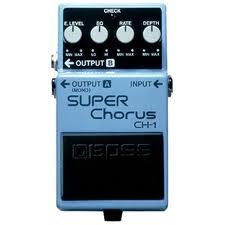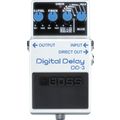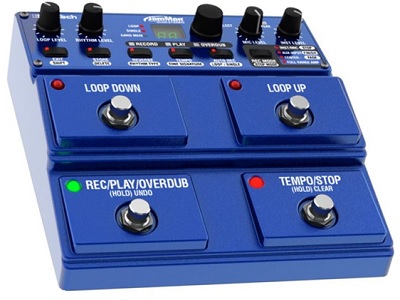How to Use Guitar Effects Correctly (Distortion, Chorus, Delay)
Guitarists are able to alter the signals of their electric guitars into a variety of sounds by using guitar effects. In modern times, guitar effects had evolved into a complex variety of sounds (distortion, chorus, delay, flanger, reverb, wah, phase shift……..etc).
Typically, guitar effects are housed into small effects pedals which are placed on the ground and activated when the guitarist steps onto them.
Using guitar effects has been made easier with the multi-effects pedals available in the market. Most of these units can be pre-programmable to store different chains of effects settings.
 This is particularly useful if you are playing live and if you would be able to recall the settings with the flick of your footswitch (instead of squatting down to tune the settings on individual pedals). One of the most powerful multi effects pedals is the BOSS GT-10. Take a look at the video demo.
This is particularly useful if you are playing live and if you would be able to recall the settings with the flick of your footswitch (instead of squatting down to tune the settings on individual pedals). One of the most powerful multi effects pedals is the BOSS GT-10. Take a look at the video demo.
On the other hand, the advantage of using many single effects pedals is that you are able to choose the best effects units of your choice across many different brands. This is as opposed to using a multi-effects pedal whereby you are stuck to what you get in the bundle. So prior to purchasing effects, you should have a clear mind of what you want.
Now, I want to introduce 3 of the most commonly used guitar effects; distortion, chorus and delay which are used in electric guitar playing.
Distortion
 Guitar distortion effects can be found in all kinds of music. On a typical distortion effects pedal, you will see the following knobs.
Guitar distortion effects can be found in all kinds of music. On a typical distortion effects pedal, you will see the following knobs.
Drive (aka Gain or Distortion) – This setting controls the amount of distortion. If you are playing lead or heavier songs, you should set this higher. On the other hand, if you are playing rhythm or blues, this knob should be set lower. Otherwise, you’ll get a poorly defined sound.
Tone (aka EQ) – Lets you determine the treble content and modify the tone of the sound.
Level – Sets the final output volume of the effect.
Combined with guitar playing techniques such as palm muting and guitar harmonics, you can create wild sounds with this pedal.
Chorus Effects
 Chorus effects can make a single guitar sound like there are several guitars being played together at the same time. This results in a sound that is much fuller. On a typical chorus pedal, you would see the following:
Chorus effects can make a single guitar sound like there are several guitars being played together at the same time. This results in a sound that is much fuller. On a typical chorus pedal, you would see the following:
EQ – Controls the tone of chorused sound
Level – Controls the volume and amount of the chorus effect.
Rate (aka Speed) – The rate refers to the speed at which the pitch variation takes place. Play around with the knobs and hear for yourself how the effects change.
Depth – The depth refers to how “off-tune” and the degree of swelling effect you want for the chorus effect. Lower settings are preferred for guitar rhythm playing. For clean plucking of strings, you may want to try a higher depth.
Digital Delay
 A delayed sound is basically an echo effect that fades away over time. Imagine shouting at the top of a mountain and hearing the echoes. With the proper use of delay, you can get really cool sounding music and loops.
A delayed sound is basically an echo effect that fades away over time. Imagine shouting at the top of a mountain and hearing the echoes. With the proper use of delay, you can get really cool sounding music and loops.
On a typical delay pedal, you would see the following:
Level – Controls the volume and amount of the delay effect.
Time – Sets the time before the delayed sound is heard. The typical values are from 300 milliseconds to about 2 seconds. Be careful with this setting as it might throw your delayed sound off with the timing of the band. If you use very small values from 15-35 milliseconds, you probably get a chorus-like sound effect. The best gauge is to hear the sound and play it out for yourself.
Feedback – This knob sets the number of repeats for the effect. I do not recommend setting this value very high unless you want your music to go into an endless loop of repeats.
Connecting Your Effects Pedals in the Correct Order
 Believe it or not, guitar effects pedals have an order. It may sound crazy, as they are only tiny metal boxes, which should mean that you can simply stick them all together in a string and call it a day, and you can; only you won’t be getting the most out of each and every pedal.
Believe it or not, guitar effects pedals have an order. It may sound crazy, as they are only tiny metal boxes, which should mean that you can simply stick them all together in a string and call it a day, and you can; only you won’t be getting the most out of each and every pedal.
First off, you need to look over your stash. What kinds of pedals do you have? Believe it or not, in the chain of command, the effects pedals that add effects are actually the least important and receive the bottom chain treatment. The most important effects pedals are the tool effects pedals, and of all of them, the tuner should always be the first pedal in line.
What Are Tool Effects Pedals?
Tool effects pedals are the pedals that aren’t actually adding to your sound by means of flanging or bouncing or wah-ing, but simply are the tools on which your rig depends. Tool effects pedals include tuners, noise gates, suppressors, and any other pedals that help you clean yourself up.
The second set of links goes to those craft effects pedals. Craft effects pedals are the pedals that craft your tone, whether that be your middle levels or your bass levels; even your distortion levels. Craft effects pedals include EQ’s, overdrives, or any other types of pedals that you use to color your guitar’s natural sound.
The Last Link Goes to the Flavor Effects Pedals
The flavor pedals are all of the pedals that add spice to your playing, including wahs, flangers, choruses, and any other pedal that adds an unnatural edge to your sound.
So now that we know the order of your pedals, we need to understand why the order is so important. Let’s start off with our tool pedals. Our tool pedals are the main pedals that help us stay in tune and avoid unwanted noise. These pedals require the strongest signal, which means they need to be closest to the guitar in order to get a clear message through the chain. Remember, the chain starts at your guitar, not your amp.
The craft pedals need a somewhat clear chain, but are less important, as they are only crafting your tone, unlike the tool pedals which are building the foundations (tuning and noise suppression) for a successful rig. That being said, craft pedals aren’t a dire necessity.
If craft pedals aren’t a dire necessity, then flavor pedals are only added cherries to the sundae of your rig. Flavor pedals are the least important pedals, and don’t require much of a signal to function, as they aren’t actually impacting your tone at all; they are only extras.
A basic signal chain for a simple effects pedal setup would look like this:
Guitar > Tuner > Noise Suppressor > Distortion > Chorus > Amp
Once you decide which guitar pedals you will need, take your time and remember that no matter how important your wah may feel, it is the least important of your pedals in the chain of command.
Last Words About Using Your Effects
There are no hard and fast rules for the order of effects. If you jumble up the order of effects, use your ears as a judge to determine whether it works out or not.
Guitar effects are really fun and cool to play with. One last piece of advice I have for you is to go easy on using guitar effects. If you want a prolonged use of an effect, you should use very “light” effects. To create a short and impactful sound, you should use intense effects (such as heavily delayed or chorused sounds) very briefly.
Looking For Step-By-Step Video Guitar Lessons?
Trusted by 200,000+ students, Jamorama is the leading provider of guitar courses. If you are looking for a fun way to learn the guitar and want to play-along to your favorite songs, check out Jamorama today…







Leave A Comment